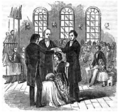Portal:Latter Day Saint movement
|
Welcome to the portal of The Latter Day Saint movement
Introduction The Latter Day Saint movement (also called the LDS movement, LDS restorationist movement, or Smith–Rigdon movement) is the collection of independent church groups that trace their origins to a Christian Restorationist movement founded by Joseph Smith in the late 1820s. Collectively, these churches have over 17 million nominal members, including over 17 million belonging to the Church of Jesus Christ of Latter-day Saints (LDS Church), 250,000 in the Community of Christ, and several other denominations with memberships generally ranging in the thousands of members. The predominant theology of the churches in the movement is Mormonism, which sees itself as restoring again on Earth the early Christian church; their members are most commonly known as Mormons, though the LDS Church now rejects the use of that name. An additional doctrine of the church allows for prophets to receive and publish modern-day revelations. A minority of Latter Day Saint adherents, such as members of Community of Christ, have been influenced by Protestant theologies while maintaining certain distinctive beliefs and practices including continuing revelation, an open canon of scripture and building temples. Other groups include the Remnant Church of Jesus Christ of Latter Day Saints, which supports lineal succession of leadership from Smith's descendants, and the more controversial Fundamentalist Church of Jesus Christ of Latter-Day Saints, which defends the practice of polygamy. (Full article...) General images -The following are images from various Latter Day Saint movement-related articles on Wikipedia.
Selected articleThe Mormon Trail is the 1,300-mile (2,100 km) long route from Illinois to Utah on which Mormon pioneers (members of the Church of Jesus Christ of Latter-day Saints) traveled from 1846–47. Today, the Mormon Trail is a part of the United States National Trails System, known as the Mormon Pioneer National Historic Trail. The Mormon Trail extends from Nauvoo, Illinois, which was the principal settlement of the Latter Day Saints from 1839 to 1846, to Salt Lake City, Utah, which was settled by Brigham Young and his followers beginning in 1847. From Council Bluffs, Iowa to Fort Bridger in Wyoming, the trail follows much the same route as the Oregon Trail and the California Trail; these trails are collectively known as the Emigrant Trail. (Full article...)Selected location
Voree (/vɔːriː/) is an unincorporated community in the Town of Spring Prairie in Walworth County, Wisconsin, United States. It is best known as the headquarters of the Church of Jesus Christ of Latter Day Saints (Strangite), a denomination of the Latter Day Saint movement. According to James Strang, founder of the Strangite church and of the town, the name means "Garden of Peace". The community is situated along former Wisconsin Highway 11, just west of the Racine County line. (Full article...)
Selected schismatic historiesThe Church of Jesus Christ of Latter Day Saints—usually distinguished with a parenthetical (Strangite)—is one of the several organizations that claim to be the legitimate continuation of the church founded by Joseph Smith on April 6, 1830. It is a separate organization from the considerably larger and better known Utah-based Church of Jesus Christ of Latter-day Saints (LDS Church). Both churches claim to be the original organization established by Smith. The Strangite church is headquartered in Voree, Wisconsin, just outside Burlington, and accepts the claims of James Strang as successor to Smith. It had approximately 300 members in 1998. An undated FAQ on the church's official website reports there are around 130 active members throughout the United States. After Smith was murdered in 1844 with no clear successor, several claimants sought to take leadership of the church which Smith founded. Among them was Strang, who competed with other prominent members, notably Brigham Young and Sidney Rigdon. (Full article...)OutlinesRelated portalsKey biographiesThe life of Joseph Smith from 1827 to 1830, when he was 22–25 years old, begins in late 1827, after Smith announced he had obtained a book of golden Plates buried in a hill near his home in Manchester, New York (near Palmyra village). Because of opposition by former treasure-seeking colleagues who believed they owned a share of the golden plates, Smith prepared to leave the Palmyra area for his wife's home town of Harmony, Pennsylvania (now Oakland). From late 1827 to the end of 1830, Smith would translate the golden plates, publish the Book of Mormon, and establish the Church of Christ. To translate the golden plates, Smith enlisted the assistance of Martin Harris, a wealthy Palmyra landowner who acted as Smith's scribe. To translate, Smith used seer stones (one set of which Smith later called the Urim and Thummim), and Smith said the stones showed him the translation. Translation ceased, however, when Harris lost 116 manuscript pages of uncopied text. Translation resumed in earnest when Smith was joined in May 1829 by a Smith family associate named Oliver Cowdery. Translation was completed near the end of July 1829, and the resulting manuscript was published as the Book of Mormon on March 26, 1830, in Palmyra. (Full article...)Selected image The "Letter of appointment" is a controversial three-page document used by James J. Strang and his adherents in their efforts to prove that he was the designated successor to Joseph Smith as the prophet and president of the Church of Jesus Christ of Latter Day Saints. Sent from Nauvoo, Illinois, on June 19, 1844, to Strang in Burlington, Wisconsin, this letter served as the cornerstone of Strang's claims, which were ultimately rejected by the majority of Latter Day Saints.
Did you know (auto generated)
Selected Anniversaries
Selected quote
TopicsFeatured contentCategoriesWikiProjectsAssociated WikimediaThe following Wikimedia Foundation sister projects provide more on this subject:
Discover Wikipedia using portals | ||||||||








































